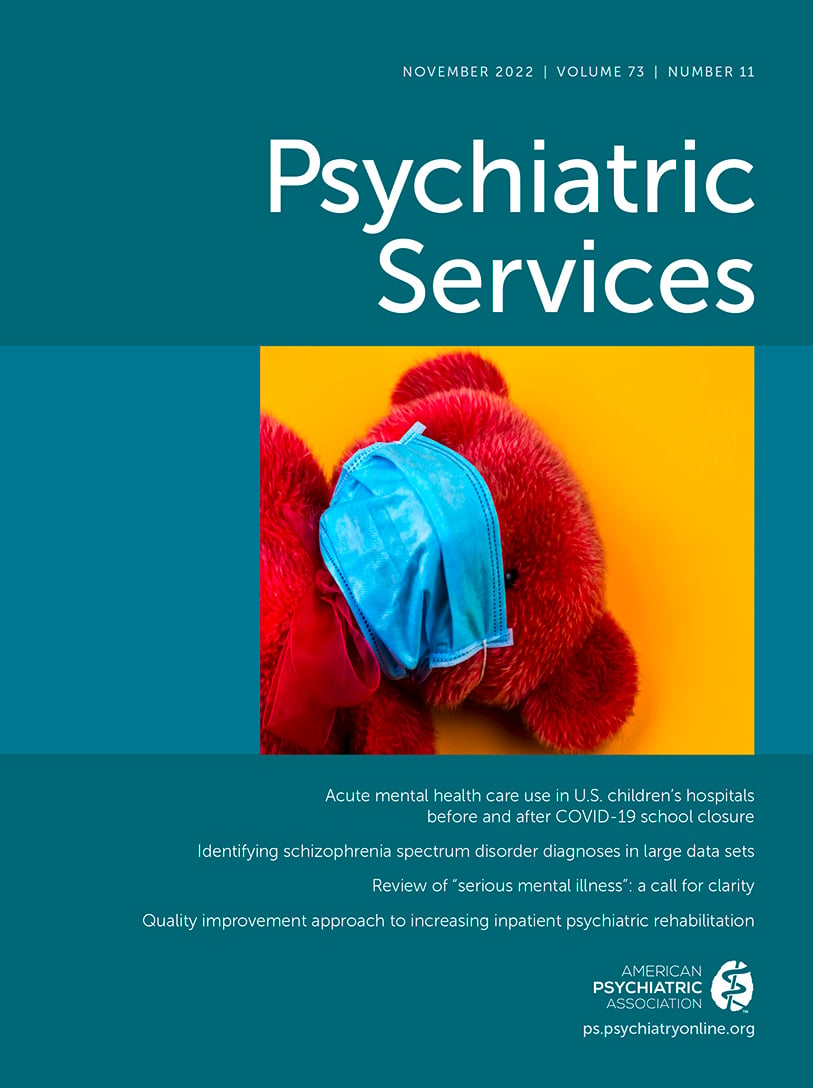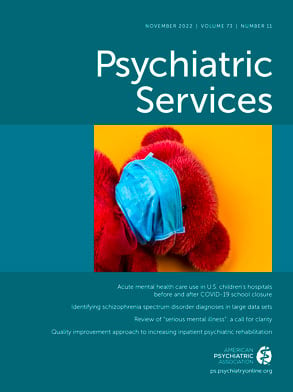The social determinants of health—“the conditions in which people are born, grow, work, live, and age, and the wider set of forces and systems shaping the conditions of daily life” (
1)—have long been recognized as powerful drivers of health. Attention has been drawn to the importance of identifying these conditions as risk factors in the clinical setting. The COVID-19 pandemic dramatically laid bare the health inequities associated with systemically driven variations in social conditions, underscoring the urgent need for this focus. Governmental agencies and other organizations have initiated efforts to capture social determinant data to inform policy-making and fiscal decisions. The Centers for Medicare and Medicaid Services (CMS) issued guidance emphasizing “opportunities … to better address social determinants of health … to support states with designing programs, benefits, and services that can more effectively improve population health, reduce disability, and lower overall health care costs … by addressing [social determinants of health]” (
2).
Our analysis describes the distribution of four social determinants (educational attainment, employment status, homelessness in the past 6 months, and current criminal legal involvement) among mental health service recipients in New York State, examines whether these factors are associated with specific psychiatric and comorbid substance use–related disorders, and explores whether the distributions of social determinants vary by gender, race and ethnicity, and geography.
Methods
Data came from the New York State Office of Mental Health (OMH) 2017 Patient Characteristics Survey. This biennial survey collects provider-reported data on approximately 180,000 patients seen during one week (October 23–29, 2017) in >4,000 programs operated or licensed by OMH. Services encompass those in the public sector (e.g., OMH- or county-operated services) as well as those licensed by the state in the private sector. Patients seen in private practices (not licensed by the state) were not included, nor were patients receiving services at Veterans Affairs (VA) hospitals or clinics. Our sample was restricted to individuals ages 18–65, without intellectual or developmental disabilities, who were receiving services for a mental illness or emotional disturbance during the survey week (N=103,416). The study protocol was approved by the Nathan Kline Institute for Psychiatric Research Institutional Review Board.
Demographic characteristics included age, gender, race and ethnicity, and region of residence (New York City vs. rest of state). Race and ethnicity were categorized as non-Hispanic White, non-Hispanic Black, Hispanic, or other. The four social determinants assessed were educational attainment (<12th grade, 12th grade/high school graduate/equivalent, >12th grade), employment status (unemployed, part-time, full-time), homelessness in the past 6 months (yes/no), and current criminal legal involvement (yes/no).
Primary psychiatric disorders of interest—anxiety disorders, depressive disorders, bipolar disorders, and schizophrenia and other psychotic disorders—were categorized as present or absent, as were comorbid alcohol-related and drug/substance-related disorders.
All statistical analyses were performed with SAS, version 9.4.
Results
Table 1 presents full results. Half the sample was female (51.3%); 44.5% were non-Hispanic White, 26.9% were non-Hispanic Black, 21.8% were Hispanic, and 6.7% were coded as other. Half (50.4%) resided in New York City. Nearly one-third were reported to have a primary diagnosis of a psychotic disorder (29.9%) and one-quarter a depressive disorder (25.9%); fewer individuals had a primary diagnosis of bipolar disorder (14.9%) or anxiety disorder (8.9%). The prevalence of co-occurring alcohol-related disorders was 13.3% and of drug-related disorders was 21.5%.
One-fifth of participants (20.9%) had <12 years of education; only 40.9% had >12 years. A majority were unemployed (79.1%), 8.2% had been homeless in the prior 6 months, and 12.2% were currently under correctional supervision (either incarcerated or in the community).
Among participants facing adverse social conditions (i.e., less than high school education, unemployment, recent homelessness, current criminal legal involvement), a psychotic disorder was the most common primary psychiatric diagnosis. The disparate distribution of social determinants was particularly pronounced among those with co-occurring substance-related disorders: 87.3% of those with drug-related disorders were unemployed, and 25.1% were currently involved in the criminal legal system. By comparison, 60.4% of those with anxiety disorders were unemployed, and 7.3% were currently involved in the criminal legal system.
Non-Hispanic Black recipients of mental health services had higher rates of unemployment (86.3%) compared with non-Hispanic White and Hispanic recipients (73.9% and 82.0%, respectively), as well as higher rates of recent homelessness (12.7% vs. 5.4% and 8.9%, respectively) and current criminal legal involvement (17.2% vs. 10.8% and 10.3%, respectively). Prevalence of each of these conditions was higher among men than among women, with the greatest discrepancy being in criminal legal involvement (19.1% among men vs. 5.7% among women). New York City residents were more likely to be unemployed and recently homeless but less likely to be under current correctional supervision.
Discussion
Although the cross-sectional nature of these data prevents the establishment of temporality or causality, the large sample size and broad statewide composition offer unique insights into relationships between social determinants, behavioral disorders, and demographic characteristics among those receiving treatment. Although only four social determinants were analyzed, they are among the most critical; in addition to directly affecting health outcomes, they are inextricably intertwined with other social determinants.
A comparison with related characteristics among the overall New York State population reveals a disparate distribution of social determinants. Our sample’s percentage of high school graduates was lower than that of the general population (79.1% vs. 86.5%, respectively) (
3). Lower educational attainment is associated with myriad poorer health outcomes, including higher death rates from heart disease, cancer, stroke, respiratory diseases, and injuries (
4), as well as with common mental disorders (
5).
The differential rates of unemployment were more dramatic: 79.1% of study participants were unemployed in late 2017, when the reported unemployment rate in New York State was 4.4% (
6). Unemployment and underemployment have been tied to increased psychiatric hospital admissions and adverse mental health outcomes, including suicide (
7). The change from employment to underemployment has been connected to onset of depressive symptoms and elevated incidence of problem drinking (
8).
Housing instability, too, has been associated with poorer physical and mental health outcomes, including depression, anxiety, suicidality, and substance use (
9). Although it is a rough comparison, 8.2% of the sample had experienced homelessness at some time in the 6 months prior to the survey, a much greater proportion than the 0.5% of the general population reported to be homeless on any given day in New York State in the same year (
10).
Involvement in the criminal legal system can be a consequence of behavioral health issues, as well as a risk factor for negative behavioral health outcomes (
11). Studies have estimated that 25%–75% of individuals with mental illnesses have a history of criminal legal involvement (
12). Our sample’s prevalence of 12.2% is considerably lower but reflects current correctional involvement rather than any criminal legal involvement history. However, compared with the rate of 1.0% of individuals with current criminal legal involvement in the general state population (i.e., those under criminal legal supervision, both incarcerated and in the community [
13]), our sample’s prevalence is remarkably higher. The higher proportion of criminal legal involvement among those living outside New York City is most likely explained by the state’s prisons being located outside the city.
Of particular concern was the higher prevalence of each adverse social determinant among people of color, especially non-Hispanic Black participants. This inequity is consistent with the literature; systemic racism perpetuates the disproportionate frequency of social adversities that people of color encounter (
14), including those identified in the present sample. Individual-level racism and discrimination against people with substance use disorders and mental illnesses may further hamper employment and educational opportunities while increasing the likelihood of involvement with the criminal legal system. Also noteworthy is the overrepresentation of non-Hispanic Black participants in our sample (26.9% vs. 15.1% of the state population). This study’s confirmation of the association between adverse social conditions and specific mental illnesses, the higher prevalence of those adversities among people of color, and the overrepresentation of people of color within the sample warrant the continued pursuit of health equity.
Causal conclusions cannot be drawn from this study’s results. We acknowledge that behavioral health diagnoses may lead to the very social and economic circumstances that put people at risk for such disorders. A bidirectional relationship may exist, compounding the likelihood of a poorer course of illness and worse outcome. For example, unemployment may increase depressive symptoms; depression may also elevate the risk of becoming unemployed.
Several limitations are noteworthy. The survey was cross-sectional and captured a limited number of social determinants. Longitudinal tracking of measures would be ideal because behavioral health disorders are influenced by early and cumulative exposure, often beginning in childhood (
15). Reliability and validity of the variables analyzed are unknown. Validity could be a concern when capturing homelessness, because responding clinicians might not be aware of a brief, recent period of homelessness. All data were obtained from providers rather than from patients; therefore, data about race and ethnicity and gender may in some instances differ based on who is reporting them. Analyses involving race and ethnicity were limited by the categories available, and race and ethnicity were combined (e.g., someone identified as Black and Latino would have been categorized as Hispanic). The category of “other” is problematic because it captures multiple racial and ethnic identities (e.g., all Asian people), making interpretations involving that category nearly impossible and adding to challenges arising from categorizing people by a social construct such as race. Because patients being seen in private practices (or in VA services) were not included in the survey, it is not known how those patients would differ from those receiving state-licensed mental health services, or to what extent the associations documented in our sample would be present among those patients. Furthermore, there was no way to compare findings with those that might be observed among patients receiving medical services who do not have psychiatric disorders.
The survey is based on data collected routinely by responding agencies and is not a comprehensive, stand-alone review of social determinants in the clinical population. Many social determinant tools include additional items (e.g., food insecurity, transportation needs). A recent survey of New York State outpatient clinics revealed a lack of standardized screening for social determinants during routine intake and assessment. The limitations of the survey’s data reflect this inadequate focus on social determinants by clinical services to date. The increased attention now being paid by governmental agencies whose financial priorities drive the focus of care is encouraging. One example of this important shift is the CMS guidance noted above, which addresses social determinants through a value-based payment structure, supports program experimentation in this area, and encourages the use of
ICD-10 Z codes for assessing social needs (
2).
Conclusions
The link between social conditions and health is clear, as are disparities in the distribution of social determinants. This study of a large sample of mental health service recipients highlights the importance of social determinant–focused work and demonstrates how statewide databases can be mined to advance this critical area of inquiry, intervention, and (ideally) prevention. Additional analyses will investigate whether data suggest a cumulative effect of adverse social conditions on substance use and comorbid medical conditions. Future work should include comprehensive, uniform screening for social determinants among behavioral health populations and longitudinal data tracking.

